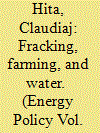| Srl | Item |
| 1 |
ID:
175228


|
|
|
|
|
| Summary/Abstract |
Several studies note the large quantity of water used to hydraulically fracture oil and gas wells. We quantify this water use and its effects on water use for irrigating crops. For nine western states in 2017, water use in fracking represented 1.7 percent of water use in irrigation overall, but up to 55 percent in the Bakken shale of North Dakota, 28 percent in Oklahoma shale regions, and 12 percent in the Eagle Ford shale of Texas. However, in counties where the percentage of water use for fracking relative to irrigation is large, it is primarily because such counties have had minimal historical irrigation. We analyze the effect of state water policies governing the transfer of water from farming to fracking on water withdrawals for the two sectors. In North Dakota, which allowed farmers to forego irrigating and sell water to energy firms, each acre-foot of water used in fracking displaced about 1.1 acre feet from irrigation, thereby avoiding an increase in total withdrawals. Weaker evidence suggests an increase in irrigation in Oklahoma and Texas. Because of the lack of displacement in Texas and Oklahoma, concerns that fracking contributes to excess withdrawals in the present time may be warranted.
|
|
|
|
|
|
|
|
|
|
|
|
|
|
|
|
| 2 |
ID:
132392


|
|
|
|
|
| Publication |
2014.
|
| Summary/Abstract |
The unconventional oil and gas revolution is certainly a game changer in the current international political setting, since it will bring the United States close to energy self-sufficiency. However, it seems unlikely that this new energy status will dramatically redefine US foreign policy and security priorities. In strategic regions such as the Middle East, US interests are expected to remain unchanged, while the new energy status will contribute only in part to modifying the US approach towards the EU's energy posture vis-à-vis Russia. What the new American energy condition is likely to change are the tools and policy options available to Washington to cope with the strategic challenges - China's power in primis - emerging in the multipolar international relations system.
|
|
|
|
|
|
|
|
|
|
|
|
|
|
|
|
| 3 |
ID:
175960


|
|
|
|
|
| Summary/Abstract |
Armen Oganesyan, Editor-in-Chief of International Affairs: While the coronavirus epidemic may not have turned the world upside down, problems building up in various spheres of human life have reached a critical mass under its impact. Naturally, the energy industry, as an important sector of the world economy, has felt its effects. It is not only that the dramatic drop in oil prices occurred at the peak of the epidemic. The thing is that for a very short historical period, the world has reached a point where we must answer many questions and address many challenges of a global nature.
|
|
|
|
|
|
|
|
|
|
|
|
|
|
|
|